A lagoon is a shallow body of water separated from a larger sea or ocean by a barrier such as a sandbank or coral reef. These unique ecosystems support diverse plant and animal life, making them vital for environmental balance. Discover more about lagoons and their ecological importance in the rest of this article.
Table of Comparison
| Feature | Lagoon | Estuary |
|---|---|---|
| Definition | Shallow coastal water body separated from ocean by barrier islands or reefs | Partially enclosed coastal body where freshwater mixes with seawater |
| Water Type | Primarily saline or brackish | Brackish, mixing freshwater and saltwater |
| Connection to Ocean | Often separated or limited exchange with ocean | Directly connected to the ocean via river mouths |
| Formation | Formed by sediment deposition, coral reefs, or sandbars | Formed by river valleys submerged by sea level rise |
| Examples | Venice Lagoon, Indian River Lagoon | Chesapeake Bay, San Francisco Bay |
| Ecological Importance | Nursery habitat, supports biodiversity, filters pollutants | Productive habitats, nutrient-rich, buffers storms |
Introduction: Understanding Lagoons and Estuaries
Lagoons are shallow coastal bodies of water separated from the ocean by barrier islands, sandbanks, or coral reefs, characterized by brackish water with limited tidal exchange. Estuaries represent dynamic environments where freshwater from rivers meets and mixes with saltwater from the ocean, creating nutrient-rich habitats with significant tidal influence. Both ecosystems play critical roles in supporting biodiversity, filtering pollutants, and acting as nurseries for various marine species.
Defining Lagoons and Estuaries
Lagoons are shallow bodies of saltwater separated from the ocean by barrier islands or reefs, often characterized by calm, protected waters and limited tidal exchange. Estuaries are dynamic environments where freshwater from rivers mixes with ocean saltwater, creating brackish conditions that support diverse ecosystems. The primary distinction lies in water sources and flow: lagoons are primarily coastal embayments with restricted ocean connectivity, while estuaries function as transitional zones with continual freshwater and tidal influence.
Key Differences between Lagoons and Estuaries
Lagoons are shallow coastal water bodies separated from the ocean by barrier islands or coral reefs, characterized by low salinity and limited tidal exchange, while estuaries are dynamic coastal zones where freshwater from rivers mixes with saltwater from the sea, resulting in higher nutrient levels and salinity gradients. Estuaries often support diverse ecosystems with high biodiversity due to their nutrient-rich waters, whereas lagoons typically exhibit less biological diversity and more stable salinity conditions. Unlike lagoons, estuaries experience significant tidal fluctuations and stronger water circulation, influencing sediment transport and habitat types.
Formation Processes: How Lagoons and Estuaries Develop
Lagoons form when coastal landforms like barrier islands or sandbars enclose shallow bodies of water, often created through sediment deposition and wave action. Estuaries develop where freshwater rivers meet and mix with seawater, shaped by tidal influences, sediment transport, and river flow dynamics. Both environments are shaped by complex interactions among hydrodynamics, sedimentation, and geological features.
Water Salinity: Characteristics in Lagoons vs Estuaries
Lagoons typically exhibit stable, often higher salinity levels due to limited water exchange with the open sea and high evaporation rates, resulting in hypersaline conditions in some cases. Estuaries experience fluctuating salinity gradients influenced by the mixing of freshwater from rivers and saline ocean water, creating brackish environments with salinity levels varying spatially and seasonally. This dynamic salinity variation in estuaries supports diverse ecosystems adapted to changing conditions, unlike the more uniform salinity in lagoons.
Biodiversity and Ecosystems
Lagoon ecosystems typically support high biodiversity due to their shallow, sheltered waters that promote diverse plant and animal species, including seagrasses, fish, and migratory birds. Estuaries, where freshwater meets seawater, create nutrient-rich environments that sustain complex food webs and serve as critical nurseries for many marine organisms. Both habitats are crucial for maintaining coastal biodiversity but differ in salinity gradients and species adaptations.
Human Impact and Environmental Concerns
Human activities in lagoons and estuaries often lead to pollution from industrial discharge, agricultural runoff, and urban development, which severely compromise water quality and aquatic habitats. Estuaries experience increased nutrient loading, causing eutrophication and hypoxia that threaten biodiversity, while lagoons face sedimentation issues that disrupt their delicate ecosystems. Conservation efforts emphasize monitoring pollution sources and restoring natural vegetation to mitigate these human impacts and protect these vital coastal environments.
Economic Importance of Lagoons and Estuaries
Lagoons and estuaries serve as critical habitats supporting commercial fisheries, aquaculture, and tourism industries, contributing significantly to local and national economies. Estuaries offer nutrient-rich waters that enhance fish production, supporting major seafood markets and providing livelihoods for coastal communities. Lagoons support biodiversity and recreational activities such as boating and birdwatching, attracting tourists and generating revenue through eco-tourism and conservation efforts.
Global Distribution and Notable Examples
Lagoons are coastal water bodies separated from the ocean by barrier islands or reefs, commonly found in tropical and temperate regions such as the Venetian Lagoon in Italy and the Indian River Lagoon in Florida, USA. Estuaries occur where freshwater rivers meet the sea, creating brackish water zones that are widespread globally, including the Chesapeake Bay in the USA and the Thames Estuary in the United Kingdom. Both lagoon and estuary ecosystems support diverse biodiversity and play critical roles in coastal protection and nutrient cycling.
Conclusion: Choosing Between Lagoon and Estuary
Choosing between a lagoon and an estuary depends on the specific ecological functions and environmental conditions desired; lagoons typically offer calmer, more isolated environments ideal for certain wildlife habitats, while estuaries provide nutrient-rich waters with dynamic tidal influences supporting diverse ecosystems. Understanding factors such as salinity gradients, water circulation patterns, and surrounding land use helps determine the best fit for conservation or development projects. Effective management leverages the unique characteristics of each, optimizing biodiversity preservation and resource sustainability.
Lagoon Infographic

 libterm.com
libterm.com